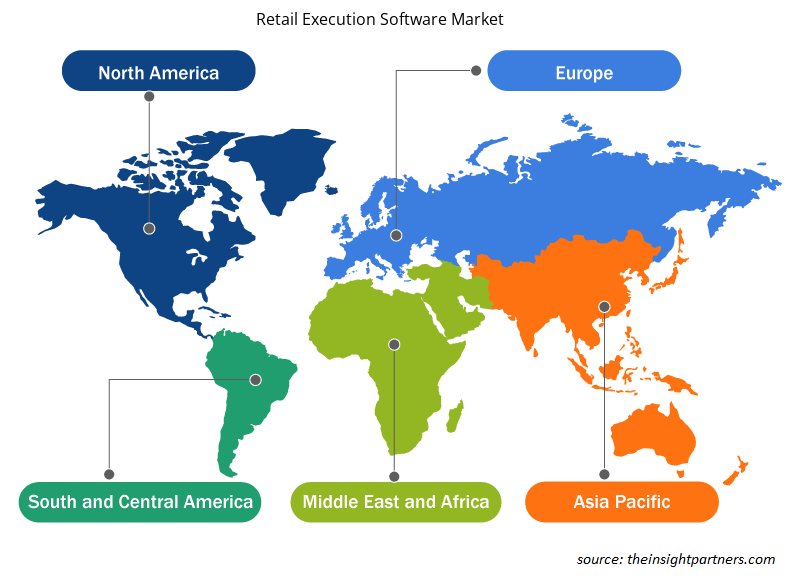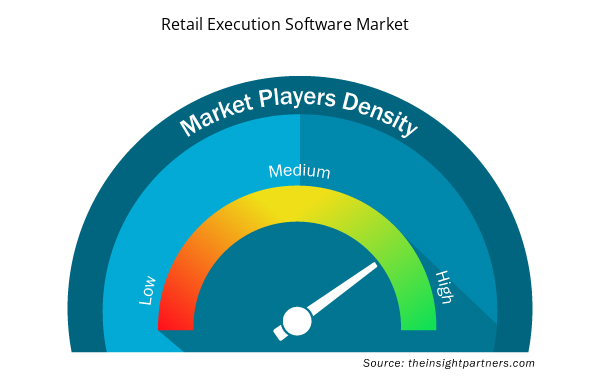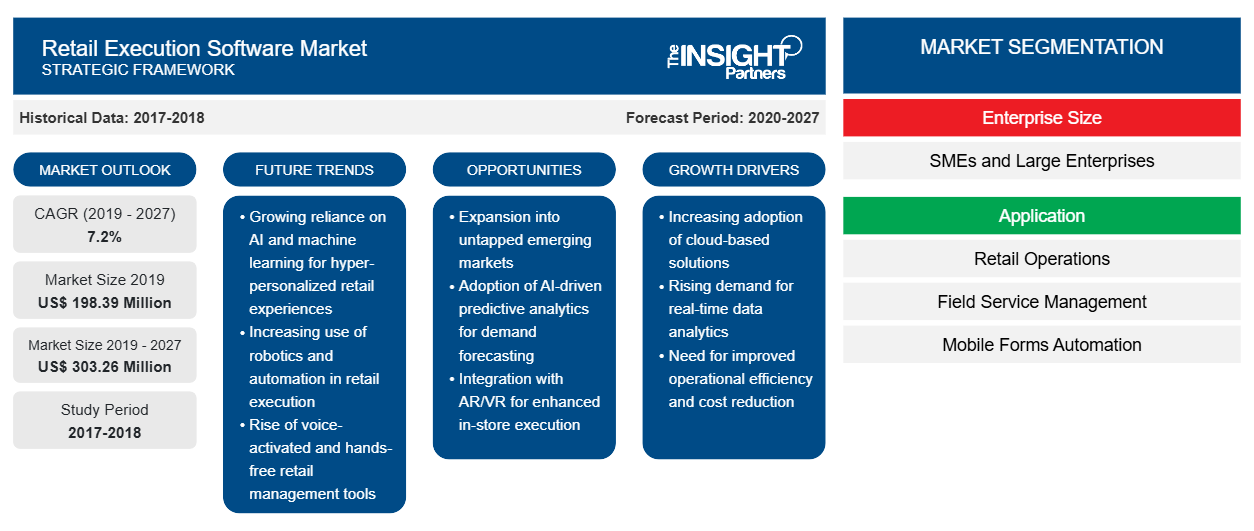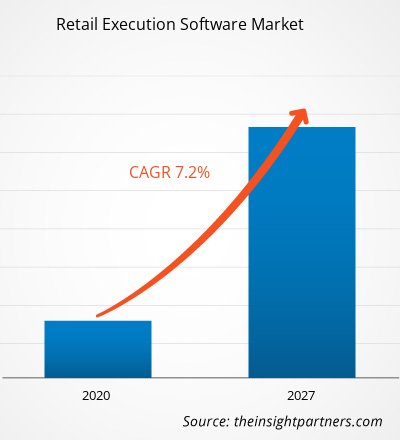소매 실행 소프트웨어 시장 규모는 2019년에 1억 9,839만 달러였으며, 2027년까지 3억 326만 달러에 도달할 것으로 예상됩니다. 2020년에서 2027년까지 연평균 성장률 7.2%로 성장할 것으로 예상됩니다.CAGR of 7.2% from 2020 to 2027.
글로벌 리테일 실행 소프트웨어 시장은 리테일 및 전자상거래 플랫폼에 대한 선호도가 높아지고 결제 게이트웨이와 리테일 실행 소프트웨어의 통합이 증가함에 따라 상당한 성장을 목격하고 있습니다. 지리적으로 북미가 31.13%의 매출 점유율로 시장을 이끌었고, 그 뒤를 유럽과 APAC가 이었습니다. 빠르게 성장하는 경제, 자동화 기술 채택 증가, 인터넷 보급률 증가, 최종 사용자의 소프트웨어 채택이 이러한 지역의 리테일 실행 소프트웨어 시장 성장을 견인할 것으로 예상되는 주요 요인 중 일부입니다. APAC 의 리테일 실행 소프트웨어 시장은 예측 기간 동안 가장 높은 CAGR로 성장할 것으로 예상됩니다. 리테일 산업에서 첨단 기술 채택이 증가함에 따라 리테일 실행 소프트웨어 채택률이 높아졌습니다. 기업은 비즈니스 운영을 간소화하기 위해 소프트웨어에 투자합니다. APAC에서 리테일 및 전자상거래가 가장 빠르게 성장하는 시장은 인도와 중국입니다. 이러한 국가의 소비자는 인터넷 보급률이 증가함에 따라 온라인 쇼핑을 선호하고 있으며, 온라인 쇼핑 트렌드는 이 지역의 여러 리테일 및 전자상거래 분야를 변화시키고 있습니다. 따라서 이러한 요인들은 APAC에서 소매 실행 소프트웨어 시장의 성장을 촉진하고 있습니다. MEA 및 SAM과 같은 다른 개발 지역도 첨단 기술 도입으로 경제를 디지털화하려는 정부 이니셔티브가 증가함에 따라 꾸준한 속도로 성장할 것으로 예상됩니다.
귀하의 요구 사항에 맞게 이 보고서를 사용자 정의하세요
이 보고서의 일부 또는 국가 수준 분석, Excel 데이터 팩을 포함하여 모든 보고서에 대한 사용자 정의를 무료로 받을 수 있으며 신생 기업 및 대학을 위한 훌륭한 혜택과 할인 혜택을 이용할 수 있습니다.
- 이 보고서의 주요 시장 동향을 알아보세요.이 무료 샘플에는 시장 동향부터 추정 및 예측까지 다양한 데이터 분석이 포함됩니다.
COVID-19 팬데믹이 소매 실행 소프트웨어 시장에 미치는 영향
세계보건기구(WHO)의 최신 보고서에 따르면, 미국, 스페인, 이탈리아, 프랑스, 독일, 영국, 러시아, 터키, 브라질, 이란, 중국이 COVID-19 발병으로 인해 가장 큰 피해를 입은 국가에 속합니다. 이 위기는 전 세계 산업에 부정적인 영향을 미치고 있습니다. 세계 경제는 2020년에 가장 큰 타격을 입었고, 2021년에도 계속될 가능성이 높습니다. 이 발병은 물류, 소매, 전자 상거래와 같은 1차 산업에 상당한 혼란을 초래했습니다. 국제 물류 사업 산업의 급격한 쇠퇴는 글로벌 소매 실행 소프트웨어 시장의 성장을 제한하고 있습니다.
소매 실행 소프트웨어 시장 통찰력
결제 게이트웨이와 소매 실행 소프트웨어의 통합 증가
소매 실행 소프트웨어 시장 성장 촉진
온라인 결제는 대부분 소비자가 모바일을 사용하여 상품을 결제하기 때문에 APAC에서 비교적 인기가 있습니다. 한국, 일본, 싱가포르, 호주와 같은 국가에서는 모바일 디지털 구매에 여러 가지 인기 있는 전자 결제 옵션이 사용됩니다. 이러한 국가의 결제 게이트웨이 회사는 기술 개발의 물결을 잡기 위해 다양한 소매 실행 소프트웨어 공급업체에 포괄적인 전자 결제 솔루션을 제공하고 있습니다. 또한 시장 성장은 결제 게이트웨이 기술의 발전과 모바일 지갑 사용의 증가에 기인합니다. 결제 게이트웨이 시스템과 소매 실행 소프트웨어의 통합 증가와 온라인 쇼핑의 증가, 청구 방법의 발전은 예측 기간 동안 소매 실행 소프트웨어에 대한 수요를 더욱 촉진할 것으로 예상됩니다.
기업 규모 기반 시장 통찰력
기업 규모에 따라 소매 실행 소프트웨어 시장은 대기업과 중소기업으로 나뉩니다. 2019년에 대기업 부문은 시장에서 상당한 점유율을 차지했습니다. 그러나 중소기업 부문은 예측 기간 동안 상당한 CAGR을 기록할 것으로 예상됩니다.
애플리케이션 기반 시장 통찰력
응용 프로그램을 기준으로 리테일 실행 소프트웨어 시장은 리테일 운영, 현장 서비스 관리, 모바일 양식 자동화, 현장 판매, 거래 프로모션 관리, 직원 참여 등으로 세분화됩니다. 2019년에 리테일 운영 부문은 시장에서 상당한 점유율을 차지했습니다. 리테일 운영에는 개인, 공급망, 매장 레이아웃, 현금 운영, 물리적 재고 관리, 마스터 데이터, 프로모션 및 가격 책정 관리가 포함됩니다. 리테일 운영을 위한 리테일 실행 소프트웨어는 오프라인 리테일 매장에 현재 정보를 활용하고 비즈니스에 도움이 되는 방식으로 활용할 수 있는 도구를 제공합니다.
기업들은 소매 실행 소프트웨어 시장에서 주목을 끌기 위해 신제품 개발에 매우 적극적이다. 예를 들어, Salesforce는 새로운 산업 제품인 Consumer Goods Cloud를 출시했는데, 이를 통해 소비재 기업은 향상된 소매 실행 기능을 통해 매출 성장을 촉진하고 ROI를 높일 수 있다. 주요 업체의 몇 가지 개발 사항은 다음과 같다.
2020: StayinFront, Inc. 소매 데이터 인사이트(RDI)는 실시간 분석을 위해 Field Sales Solutions와의 파트너십을 확대했습니다. StayinFront RDI의 현장 보기와 ROI 보기는 현장 영업팀에 실행 가능한 인사이트를 제공합니다. 이 서비스는 매장 내 효과를 촉진하고 극대화하여 Field Sales Solutions의 고객이 더 많은 것을 하고, 더 많이 알고, 더 많이 판매할 수
있도록 합니다. 2018: Intelligence Retail은 IBM에 주요 제공 서비스를 개선하고 고객이 주요 매장 감사 지표를 실시간으로 추적할 수 있도록 접근했습니다. 임베디드 IBM Watson Analytics 기술을 기반으로 하는 Intelligence Retail 솔루션의 새로운 분석 모듈은 선반의 상품 가용성, 선반 점유율, 가격 및 프로모션을 포함하여 빅 데이터를 실시간으로 처리하여 소매 감사의 주요 지표를 효과적으로 추적하도록 설계되었습니다.
소매 실행 소프트웨어 시장 지역 통찰력
Insight Partners의 분석가들은 예측 기간 동안 소매 실행 소프트웨어 시장에 영향을 미치는 지역적 추세와 요인을 철저히 설명했습니다. 이 섹션에서는 북미, 유럽, 아시아 태평양, 중동 및 아프리카, 남미 및 중미의 소매 실행 소프트웨어 시장 세그먼트와 지리에 대해서도 설명합니다.

- 소매 실행 소프트웨어 시장에 대한 지역별 특정 데이터 얻기
소매 실행 소프트웨어 시장 보고서 범위
| 보고서 속성 | 세부 |
|---|---|
| 2019년 시장 규모 | 1억 9,839만 달러 |
| 2027년까지 시장 규모 | 3억 326만 달러 |
| 글로벌 CAGR (2019-2027) | 7.2% |
| 역사적 데이터 | 2017-2018 |
| 예측 기간 | 2020-2027 |
| 다루는 세그먼트 | 기업 규모별
|
| 포함된 지역 및 국가 | 북아메리카
|
| 시장 선도 기업 및 주요 회사 프로필 |
|
소매 실행 소프트웨어 시장 참여자 밀도: 비즈니스 역학에 미치는 영향 이해
소매 실행 소프트웨어 시장은 소비자 선호도의 변화, 기술 발전, 제품의 이점에 대한 인식 증가와 같은 요인으로 인해 최종 사용자 수요가 증가함에 따라 빠르게 성장하고 있습니다. 수요가 증가함에 따라 기업은 제품을 확장하고, 소비자의 요구를 충족하기 위해 혁신하고, 새로운 트렌드를 활용하여 시장 성장을 더욱 촉진하고 있습니다.
시장 참여자 밀도는 특정 시장이나 산업 내에서 운영되는 회사나 기업의 분포를 말합니다. 주어진 시장 공간에 얼마나 많은 경쟁자(시장 참여자)가 존재하는지 그 규모나 전체 시장 가치에 비해 나타냅니다.
소매 실행 소프트웨어 시장에서 운영되는 주요 회사는 다음과 같습니다.
- 비좀(Mobisy Technologies Private Limited)
- EdgeCG(StayinFront, Inc.),
- 인텔리전스 리테일
- 모비소프트
- 팝프로브
면책 조항 : 위에 나열된 회사는 어떤 특별한 순서에 따라 순위가 매겨지지 않았습니다.

- 소매 실행 소프트웨어 시장 주요 주요 업체 개요를 알아보세요
기업 규모별
- 대기업
- 중소기업
응용 프로그램으로
- 소매 운영
- 현장 서비스 관리
- 모바일 양식 자동화
- 현장 영업
- 무역 진흥 관리
- 직원 참여
- 기타
지리별로
북아메리카
- 우리를
- 캐나다
- 멕시코
유럽
- 프랑스
- 독일
- 이탈리아
- 영국
- 러시아 제국
- 유럽의 나머지 지역
아시아 태평양(APAC)
- 중국
- 인도
- 대한민국
- 일본
- 호주
- APAC의 나머지 지역
중동 및 아프리카(MEA)
- 남아프리카 공화국
- 사우디 아라비아
- 아랍에미리트
- MEA의 나머지
남미(SAM)
- 브라질
- 아르헨티나
- SAM의 나머지
회사 프로필
- 비좀(Mobisy Technologies Private Limited)
- EdgeCG (StayinFront, Inc.)
- 인텔리전스 리테일
- 모비소프트
- 팝프로브
- 스프링 모바일 솔루션 주식회사
- 트랙스 테크놀로지 솔루션스 주식회사
- 발롬니아
- 위닛
- 칸타 그룹
- 역사적 분석(2년), 기준 연도, CAGR을 포함한 예측(7년)
- PEST 및 SWOT 분석
- 시장 규모 가치/양 - 글로벌, 지역, 국가
- 산업 및 경쟁 환경
- Excel 데이터 세트


- Authentication and Brand Protection Market
- Genetic Testing Services Market
- Battery Testing Equipment Market
- Point of Care Diagnostics Market
- Skin Tightening Market
- Retinal Imaging Devices Market
- Pharmacovigilance and Drug Safety Software Market
- Cut Flowers Market
- Medical Audiometer Devices Market
- Bio-Based Ethylene Market

Report Coverage
Revenue forecast, Company Analysis, Industry landscape, Growth factors, and Trends

Segment Covered
This text is related
to segments covered.

Regional Scope
North America, Europe, Asia Pacific, Middle East & Africa, South & Central America

Country Scope
This text is related
to country scope.
자주 묻는 질문
The retail operations segment led the retail execution software market with a market share of 33.3% in 2019. Further, it is expected to garner 30.9% share by 2027. Retail operations involves the management of individuals, supply chain, store layout, cash operations, physical inventory, and management of master data, promotions and pricing, etc. Retail execution software for retail operations equips brick-and-mortar retail stores with tools to take advantage of their current information and leverage it in a way that benefits their business. This information is often obtained from POS systems, retail management systems, and other retail use software daily. This information is taken and analyzed by the retail operations platform, providing managers and business owners with usable insights. Pricing, inventory management, or store layout can be the focus of these insights. The objective is to optimize a store user data that the store is already collecting for maximum sales. Retail operations may be integrated to manage retail POS software, retail management systems, or retail task management software.
North America dominated the retail execution software market in 2019 with a share of 31.1%; and is expected to lose its market share during the forecast period. APAC is anticipated to hold the largest market share by 2027, followed by North America and Europe. APAC is anticipated to grow at the highest CAGR during the forecast period. The region comprises prime nations such as China, India, Japan, South Korea, and Australia. Rising adoption of advanced technologies in the retail industry is drives the adoption rate of retail execution software. Companies invest in software to streamline their business operations.
The retail and e-commerce industry provides a huge platform for shopping. It is increasing at an unprecedented rate across the globe. Retail and e-commerce platforms also help various businesses to reach their customers easily; hence, necessary exposure to business is achieved. According to the Census Bureau of the Department of Commerce, US retail e-commerce sales were US$ 160.3 billion for the first quarter of 2020, an increase of 2.4% from the fourth quarter of 2019. Growing retail and e-commerce industries in APAC and North America are thriving in the business for retail execution software. The retail execution software is used for planning, managing, and monitoring the in-store activities in the consumer packaged goods (CPG) industry—such as retail operations, field sales, trade promotion management, field service management, mobile forms automation, and employee engagement. These software facilitate to enhance the collaboration between CPG companies and retailers to increase profits and optimize in-store sales. This factor is scaling up the retail execution software market size year-on-year.
Trends and growth analysis reports related to Technology, Media and Telecommunications : READ MORE..
The List of Companies - Retail Execution Software Market
- Bizom (Mobisy Technologies Private Limited)
- EdgeCG (StayinFront, Inc.),
- Intelligence Retail
- Mobisoft
- POPProbe
- Spring Mobile Solutions, Inc.
- Trax Technology Solutions Pte Ltd.
- Valomnia
- WINIT
- Kantar Group
The Insight Partners performs research in 4 major stages: Data Collection & Secondary Research, Primary Research, Data Analysis and Data Triangulation & Final Review.
- Data Collection and Secondary Research:
As a market research and consulting firm operating from a decade, we have published and advised several client across the globe. First step for any study will start with an assessment of currently available data and insights from existing reports. Further, historical and current market information is collected from Investor Presentations, Annual Reports, SEC Filings, etc., and other information related to company’s performance and market positioning are gathered from Paid Databases (Factiva, Hoovers, and Reuters) and various other publications available in public domain.
Several associations trade associates, technical forums, institutes, societies and organization are accessed to gain technical as well as market related insights through their publications such as research papers, blogs and press releases related to the studies are referred to get cues about the market. Further, white papers, journals, magazines, and other news articles published in last 3 years are scrutinized and analyzed to understand the current market trends.
- Primary Research:
The primarily interview analysis comprise of data obtained from industry participants interview and answers to survey questions gathered by in-house primary team.
For primary research, interviews are conducted with industry experts/CEOs/Marketing Managers/VPs/Subject Matter Experts from both demand and supply side to get a 360-degree view of the market. The primary team conducts several interviews based on the complexity of the markets to understand the various market trends and dynamics which makes research more credible and precise.
A typical research interview fulfils the following functions:
- Provides first-hand information on the market size, market trends, growth trends, competitive landscape, and outlook
- Validates and strengthens in-house secondary research findings
- Develops the analysis team’s expertise and market understanding
Primary research involves email interactions and telephone interviews for each market, category, segment, and sub-segment across geographies. The participants who typically take part in such a process include, but are not limited to:
- Industry participants: VPs, business development managers, market intelligence managers and national sales managers
- Outside experts: Valuation experts, research analysts and key opinion leaders specializing in the electronics and semiconductor industry.
Below is the breakup of our primary respondents by company, designation, and region:

Once we receive the confirmation from primary research sources or primary respondents, we finalize the base year market estimation and forecast the data as per the macroeconomic and microeconomic factors assessed during data collection.
- Data Analysis:
Once data is validated through both secondary as well as primary respondents, we finalize the market estimations by hypothesis formulation and factor analysis at regional and country level.
- Macro-Economic Factor Analysis:
We analyse macroeconomic indicators such the gross domestic product (GDP), increase in the demand for goods and services across industries, technological advancement, regional economic growth, governmental policies, the influence of COVID-19, PEST analysis, and other aspects. This analysis aids in setting benchmarks for various nations/regions and approximating market splits. Additionally, the general trend of the aforementioned components aid in determining the market's development possibilities.
- Country Level Data:
Various factors that are especially aligned to the country are taken into account to determine the market size for a certain area and country, including the presence of vendors, such as headquarters and offices, the country's GDP, demand patterns, and industry growth. To comprehend the market dynamics for the nation, a number of growth variables, inhibitors, application areas, and current market trends are researched. The aforementioned elements aid in determining the country's overall market's growth potential.
- Company Profile:
The “Table of Contents” is formulated by listing and analyzing more than 25 - 30 companies operating in the market ecosystem across geographies. However, we profile only 10 companies as a standard practice in our syndicate reports. These 10 companies comprise leading, emerging, and regional players. Nonetheless, our analysis is not restricted to the 10 listed companies, we also analyze other companies present in the market to develop a holistic view and understand the prevailing trends. The “Company Profiles” section in the report covers key facts, business description, products & services, financial information, SWOT analysis, and key developments. The financial information presented is extracted from the annual reports and official documents of the publicly listed companies. Upon collecting the information for the sections of respective companies, we verify them via various primary sources and then compile the data in respective company profiles. The company level information helps us in deriving the base number as well as in forecasting the market size.
- Developing Base Number:
Aggregation of sales statistics (2020-2022) and macro-economic factor, and other secondary and primary research insights are utilized to arrive at base number and related market shares for 2022. The data gaps are identified in this step and relevant market data is analyzed, collected from paid primary interviews or databases. On finalizing the base year market size, forecasts are developed on the basis of macro-economic, industry and market growth factors and company level analysis.
- Data Triangulation and Final Review:
The market findings and base year market size calculations are validated from supply as well as demand side. Demand side validations are based on macro-economic factor analysis and benchmarks for respective regions and countries. In case of supply side validations, revenues of major companies are estimated (in case not available) based on industry benchmark, approximate number of employees, product portfolio, and primary interviews revenues are gathered. Further revenue from target product/service segment is assessed to avoid overshooting of market statistics. In case of heavy deviations between supply and demand side values, all thes steps are repeated to achieve synchronization.
We follow an iterative model, wherein we share our research findings with Subject Matter Experts (SME’s) and Key Opinion Leaders (KOLs) until consensus view of the market is not formulated – this model negates any drastic deviation in the opinions of experts. Only validated and universally acceptable research findings are quoted in our reports.
We have important check points that we use to validate our research findings – which we call – data triangulation, where we validate the information, we generate from secondary sources with primary interviews and then we re-validate with our internal data bases and Subject matter experts. This comprehensive model enables us to deliver high quality, reliable data in shortest possible time.


 이 보고서에 대한 무료 샘플을 받으세요
이 보고서에 대한 무료 샘플을 받으세요